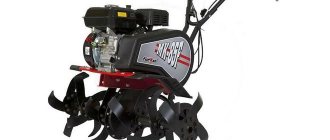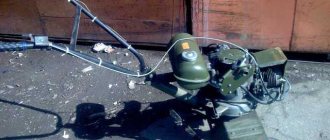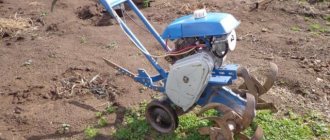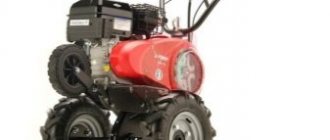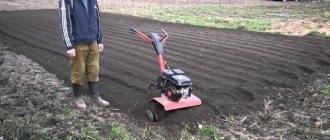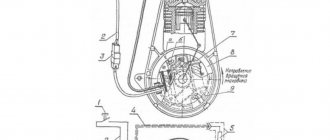The strategically important period for soil preparation is spring - autumn. Gardeners and gardeners “digging” for their pleasure in the soil. Many of them want to make their work easier.
They use advanced technology and garden tools, of which there are a large number and variety of models on sale. Domestic and foreign manufacturers annually release new samples of their products onto the market.
The Sibiryak cultivator will help you mechanize the process of tillage on your site. This is an ideal option for your 6-12 acres.
Everything, or almost everything, about the Sibiryak cultivator
The strategically important period for soil preparation is spring - autumn.
Gardeners and gardeners “digging” for their pleasure in the soil. Many of them want to make their work easier. They use advanced technology and garden tools, of which there are a large number and variety of models on sale. Domestic and foreign manufacturers annually release new samples of their products onto the market.
The Sibiryak cultivator will help you mechanize the process of tillage on your site. This is an ideal option for your 6-12 acres.
Specifications
The table details the technical parameters of the product.
The Siberian cultivator instruction manual provides an understanding of the sequence of assembly, adjustment and operation. Tells you how to carry out your first launch. How to store equipment, maintenance options and storage recommendations. What to pay attention to. And how to protect yourself from troubles. For example, you cannot fill the tank with fuel while the power unit is running.
The Siberian cultivator assembly diagram is described in detail in the instruction manual, which comes with the product when sold.
Electric cultivator Hyundai T2000-E: description, characteristics, photos, reviews, price, video.
The structure of the Swift cultivator is here.
Possible malfunctions, their elimination, repair
Each type of technology has certain characteristics. This also applies to Krot motor cultivators, so strict adherence to the manufacturer’s recommendations is the key to long-term uninterrupted operation of the machines.
As the experience of most equipment owners testifies, the main causes of malfunctions and breakdowns of the Mole MK-1A-02 motor cultivator come down to one thing: contamination of parts, components and mechanisms. Therefore, keeping agricultural machinery clean and timely maintenance should be the main rule of successful operation.
- If the carburetor is dirty, the Mole MK-1A-02 motor-cultivator will overheat and stall.
- The engine may not develop sufficient power due to clogging of the carburetor, the appearance of carbon deposits in the muffler, on the cylinder channels, or clogging of the engine air filter. The reasons may also be an increase in the tension of the V-belt, lack of compression.
- Do not use pure gasoline, not mixed with oil, as fuel.
- Do not use motor oil of brands that are not specified in the operating instructions.
- Do not idle the engine for more than 10 minutes - due to low fuel consumption, the crankshaft bearing is not cooled enough and quickly overheats, which can lead to seizure.
- For easy engine starting, promptly clean the drainage hole in the fuel tank cap and the filter element.
- Due to insufficient engine warm-up, a dirty spark plug, or improper installation of the high-voltage wire tip, the engine may stall or operate intermittently.
Magneto - ignition system control
The system is tested visually, using a probe to measure the gap between the electrodes. For a detailed inspection of the magneto, remove the casing and flywheel and make the necessary adjustments in accordance with the instructions.
Mole cultivator ignition system
The operating instructions for the Krot motor-cultivator provide very detailed information about the design of the unit, the schedule of routine maintenance, setting up systems and mechanisms, causes of problems and their elimination:
Important Technical characteristics of the TOP 7 modifications of KK gantry cranes
“The Mole cultivator has been doing all the work on my farm for many years. And not only for cultivating the land, but also for transporting the crop. A simple unit, probably couldn’t be simpler, good characteristics. The main thing is to prepare the fuel mixture correctly, change consumables on time, and adapt to the work. If the soil is dense and the cultivator tries to jump up, I deepen the coulter with force, and then it goes on normally. There have been no serious breakdowns in 7 years, only prevention.”
Recommendations for purchasing
It is important to find out the issue of warranty and the location of service centers.
Be sure to learn everything about the gearbox. Is it possible to repair it or not? Equipment with gearboxes that cannot be repaired goes on sale. If it fails, it needs to be replaced. And this, as you understand, is a large financial cost. Select equipment that is comparable in power to the work to be done. Plan to purchase a cultivator with a mandatory power reserve. This will enable high-quality soil cultivation.
Remember that when choosing a technique, it is important to compare the power of the power unit with the grip. For one liter With. there must be 200 mm of grip!
If you are planning to purchase a cultivator with a 600 mm grip, then the power of the unit should be 3 liters. With.
Compact motor-cultivator Sibiryak MK-3-02 of domestic production
Russian-made gardening equipment, the Sibiryak motor-cultivator, is an indispensable assistant for cultivating the soil in the garden and local area. The product is reliable, unpretentious, easy to operate and maintain. Light weight and compactness ensure minimal effort during excavation work, ease of movement and transportation of equipment. A set of options adds functionality to the machine and expands its scope of application.
Device and attachments
The MK-3-02 cultivator has a device that is standard for equipment in its class:
- Power point. The unit is equipped with an air-cooled four-stroke gasoline engine. In its basic configuration, it is equipped with an American Lifan 168F-2 engine, assembled under license in China. The engine has low noise and vibration levels, which ensures comfortable operation of the equipment.
- Frame. Designed for fastening cultivator components and mechanisms. The frame is assembled by welding from hardened steel. Metal protection from corrosion is ensured by an anti-corrosion coating applied to it. Support wheels with adjustable ground clearance are installed on the rear of the frame.
- Transmission. Torque is transmitted to the drive axle via a chain gearbox. The moving parts are located in the oil sump, which ensures constant lubrication of the moving parts.
- Controls. They are a double handle on which there are levers and buttons. The handle is adjustable in angle, width and height. To work at night, a headlight powered by an external battery is used.
- Protective devices. The working bodies at the back and sides are equipped with plastic casings that retain soil, stones and plant roots. The engine is equipped with a temperature sensor that signals a critically high temperature.
The following attachments can be installed on the cultivator:
- Milling cutters. They are blades mounted on a square base. Milling cutters perform the functions of loosening the soil, preparing small pits, weeding beds and vegetable gardens from weeds. The blades are made of durable alloy steel that can withstand high mechanical loads.
- Hiller. The product is made in the form of disks, the edges of which can be smooth or jagged. Used to create beds from loosened soil and fill grooves after planting seeds or tubers in them.
- Front blade. Designed for clearing paths and areas from fresh snow. Can be used to move bulk material over short distances.
- Pneumatic wheels. Mounted on an axle, they are used to tow garden wheelbarrows weighing up to 100 kg.
Motor cultivator Neva MK-100
The Neva MK-100 motor cultivator is an agricultural device designed to perform work on light and dense soils. It is designed for processing small or medium-sized plots of land (up to 10 acres).
The unit is easy to use, quite lightweight, and can be operated even by a person of low weight and short stature. This universal cultivator model is suitable for dachas, garden plots, and vegetable gardens.
Motor cultivator Neva MK 100
Overview of modifications
The manufacturer of the Neva MK-100 is St. Petersburg. The company produces not only motor cultivators, but also walk-behind tractors, as well as attachments for these types of equipment.
Currently, the following modifications of the MK-100 are known on the motorcycle market:
- MK100-02 with a Briggs & Stratton engine made in the USA (cylinder with cast iron liner);
- MK100-04, MK100-05 with Japanese Honda GC engine (overhead valve timing);
- MK100-07 with a Japanese Robin-Subaru engine (an engine with an increased service life of 2 thousand hours);
- MK100-07r - identical to the previous model, produced with protective disks for cutters;
- MK100-08 with Robin-Subaru EX13 engine (also known as Neva MK100-mini);
- MK100-09 with Japanese Honda GX120 engine.
Engine Robin-Subaru EX13
Older models have less weight, so they are less popular when working with heavy soils. This is obvious - the smaller the weight of the machine, the harder it is to perform high-quality cultivation of the land with its help. However, the first modifications, for example, MK100-02, had a lot of weight and a powerful engine.
- moderate weight;
- maneuverability;
- compactness and ergonomic design;
- low center of gravity;
- possibility of adjusting the height of the steering wheel;
- easy engine starting;
- high engine reliability, durability;
- electronic ignition system;
- gear-chain reducers on all modifications;
- possibility of connecting a trolley;
- front folding support wheel;
- The cultivator takes up little space when folded and fits in the trunk of a passenger car;
- protective discs on the cutters allow you to use the device even in narrow beds, without damaging the planted plants;
- possibility of connecting a large number of attachments (plow, hiller, lugs, harrow).
Important Electric cultivator Giardino Club 750W WR8005-750-320U0
Specifications
The cultivators are assembled on a conveyor belt equipped with computerized equipment. Each product goes to the technical control department, where its appearance, configuration and performance are checked.
Technical characteristics of the unit:
- power - 4.0 hp;
- number of cylinders - 1;
- working volume - 120 cm³;
- axis rotation speed - 120 rpm;
- fuel tank capacity - 3200 ml;
- fuel - AI-92 gasoline;
- engine lubrication oil - SAE/10W-30;
- starter - manual;
- fuel consumption - 2.0-2.8 l/h;
- gears - 1 forward;
- maximum loosening depth - 25 cm;
- soil handling width - 60 cm and 83 cm;
- dimensions - 40 x 50 x 85 cm;
- weight with cutters - 80 kg.
The equipment is supplied with a set of wrenches, a spare spark plug, a lubrication card and an instruction manual. The product is packed in a cardboard box.
Technical characteristics of the MK-1A-02 model
- Two-stroke air-cooled carburetor engine;
- Engine power at 5500-6500 rpm. — 1.9 kW, 2.6 hp;
- Fuel - a mixture of A-76, AI-80 gasoline with M-12TP oil;
- Fuel tank volume - 1.8 l;
- Processing width - 350, 600 mm;
- One gear - forward;
- Weight - 48 kg;
- Overall dimensions in working position 1300x810x1060 mm;
- Processing depth - up to 250 mm;
- Milling productivity - 150-200 m2/hour.
Operating and repair instructions
The manual for the walk-behind tractor consists of sections that describe its purpose, design, safety measures, instructions for first start-up and running-in, maintenance and storage rules, malfunctions and methods for eliminating them.
The operating rules for the equipment are as follows:
- The first start must be carried out after turning the shaft manually. This is necessary so that the oil passes through the entire system and lubricates the rubbing parts.
- Run-in is carried out for 10-12 hours. All this time the machine should operate at half the rated load. It is recommended to weed light sandy soil.
- Before you begin cultivating the soil, you need to walk through the area and collect stones, glass and metal objects from it that could damage the attachments.
- Do not allow people or animals near the operating unit. Loosening should be carried out wearing a gauze bandage and safety glasses.
- After hilling is completed, the garden tool must be inspected for damage and absence of play. The working parts should be cleaned of dirt, grass and branches, and then lubricated. Sharpening of cutters is not provided.
Equipment needs to be preserved for the winter. The attachments and handle are removed from it, and the spark plug is unscrewed. The cylinder is filled with oil, the cutters and hillers are covered with thick lubricant and wrapped in thick paper. The product is covered with fabric to protect it from animals and ultraviolet radiation. It is recommended to store equipment in a dry, warm and well-ventilated area.
Description
The “Mole” motor-cultivator appeared in the early 80s of the last century and immediately gained popularity among rural residents and dacha owners. This is not surprising, because with the help of this agricultural technology, mechanized soil cultivation, as well as planting, care and harvesting, became possible.
Over more than 30 years of its existence, “Mole” has been modified more than once. Such parts as the engine, gearbox, handles, cutters, as well as other equipment (including attachments) were brought to perfection. Having gone through a difficult path of improvements, we no longer received the original motor cultivator, which has some limitations in operation, but a multifunctional motorized device, with which we can easily carry out the following field work:
- plowing the soil;
- cutting beds;
- planting potatoes;
- spud of plants;
- weeding plants from weeds;
- mechanized potato harvesting;
- mowing;
- irrigation;
- transportation of bulk and piece goods;
- snow removal.
In order to perform all of the above work, you need to acquire the appropriate tools. You can find out more in the article about attachments for the Mole cultivator on our website.
No matter how powerful your unit is, no matter how much you care for it, sometimes it still requires repair - the engine won’t start, the engine gets hot, or some other malfunction... To know how to repair a motor cultivator, you need to understand its structure.
Common breakdowns
What machine elements may require the operator's close attention?
Let's list them:
- motor;
- magneto, ignition system;
- carburetor;
- gearbox;
- air filter, etc.
Now let’s take a closer look at all those malfunctions that can affect the performance of the unit, no matter what model it belongs to.
Does not start
So, what to do if the “Mole” does not start, what could be the reasons for this? The ignition fails or there is no ignition at all in the following cases:
- No spark. This could mean the spark plug is burnt out. In this case, you need to unscrew it and simply replace it with a new working one.
- The spark plug is smoked. A good cleaning will bring it back to life (remove carbon deposits, clean the contact), after which the spark plug must be thoroughly rinsed in gasoline.
- If the cultivator does not start, but there is a spark, then most likely the reason is a lack of insulation. We look at the candle again, in this case it is wet or slightly damp. You don't have to change the entire spark plug; you only need to replace the tip.
- Poor quality fuel may cause the cultivator to fail to ignite. It is for this reason that the spark gets wet, after which you will have to change the tip.
- Fuel dripping from the spark plug is another reason why the car will not start. To rectify the situation, it is necessary to drain the cylinder by bleeding the engine using a manual starter.
- The reason for the lack of ignition may also be problems with the fuel supply hoses. To restore the operation of the cultivator, it is necessary either to properly tighten the hoses, or, in case of rupture, replace them with new ones.
- Poor insulation of the electrical system (high and low voltage wires) can also cause the unit to not start.
- Pay attention to the air filter. If it is dirty, then problems with ignition are guaranteed. It needs to be either cleaned or replaced. Most often they resort to the second option, fortunately, this spare part is available both in price and in availability in the store.
- Failure of the magneto itself. This part cannot be repaired and is immediately replaced with a new one. How to check the magneto of the “Mole” motor-cultivator to make sure it is faulty? Yes, it’s very simple - if all the reasons why there may be no spark are excluded, then the cause of the malfunction is in the magneto. Many craftsmen rework the working magneto, thereby increasing its service life.
Possible malfunctions and repairs
During the operation of the walk-behind tractor, various breakdowns and malfunctions may occur. Because of this, farmers have a desire to repair the Mole unit with their own hands. In most cases, problems arise with the following working bodies:
- Engine.
- Magneto, ignition system.
- Gearbox.
- Air filters.
- Carburetor.
To understand how to repair a Mole cultivator, you should understand in detail the main causes of problems and their solutions.
How to start
If the Mole motor cultivator does not start, this may be due to the following breakdowns and problems:
- No spark. The ignition spark may have burned out. To eliminate the defect, you need to replace the spark plug.
- The candle became covered with soot. To restore its functionality, it is enough to perform a deep cleaning with gasoline.
- If there is a good spark, but the engine does not start, you should look at the quality of the insulation. Sometimes it becomes necessary to replace the tip.
- Low quality fuel mixture.
- Fuel dripping from spark plug.
- Problems with the air filter. If it is covered with dirt, problems with ignition cannot be avoided.
- Damage to magneto. Such a unit cannot be restored, so you will need to purchase a new one.
How to replace the engine
The need to replace the engine arises when it fails. The problem is often associated with the absence or poor quality of the fuel mixture, problems with the ignition system, or decompression that has caused piston wear and deformation of the exhaust valve.
If the problem is due to low-quality fuel, then it is enough to replace it. If there are more dangerous breakdowns, you will have to install a Honda, Lifan, Subaru or other model engine.
Installing the engine yourself is not difficult. The main thing is to adhere to the diagram, which indicates the required installation parameters.
How to set the ignition
In case of malfunctions in the ignition system, it is necessary to check the functionality of the spark plug by first unscrewing it and inspecting it.
The wet spark plug represents the importance of drying the cylinders using the recoil starter. The serviceability of the spark plug is checked with a multimeter, which determines the voltage readings in the OM
Magneto
If the magneto fails, it will be impossible to restore it. The only solution is to buy a new, working device.
Gearbox
The role of the gearbox is to transmit torque from the motor to the shaft. If it fails, the operation of the walk-behind tractor will be impossible. To restore the system, you need to understand its structure and the specifics of repair.
Reverse
Modern models of Mole cultivators are equipped with a reverse (reverse) gear option, which expands their functionality and performance properties. Reverse gear failure is rare, but if it does happen, it will need to be replaced.
Belt replacement
When replacing a belt, it is necessary to determine its size and performance properties. Their description is indicated in the technical documentation for the motor cultivator.
How to adjust the carburetor
Adjusting the K60V carburetor is an important maintenance step. To carry it out, it is necessary to study the design features and structure of the agricultural machine. To change the speed and adjust the supply of the fuel mixture, 2 screws are engaged:
- Speed screw.
- Fuel supply screw.
After winter downtime, before starting the cultivator, it is necessary to disassemble the carburetor and clean it.
Maintenance
What does maintenance mean? This is a series of measures that ensure proper operation and proper storage of equipment. Maintenance of the “Mole” cultivator means the following work:
- washing;
- cleaning;
- lubricant;
- control;
- gas station;
- control;
- fasteners;
- adjustment of all blocks and systems
Such work must be done as often as possible, especially if you have to work in unfavorable conditions.
Before starting the cultivator engine, it is necessary to check the presence of fuel, oil, etc. It is necessary to fill the mixture to a certain level, and if necessary, replace the fuel and oil. For cultivators, Avtol oil (M-8V) is used, which proved itself during the Soviet Union.
If it is difficult to get it, then you can use analogues:
- 10W-30 (do not use at temperatures above +27 degrees);
- SAE 30 (do not use at temperatures below +4 degrees).
Adjustment work involves adjusting the clutch, reverse gear, carburetor, spark, etc.
Cleaning work includes cleaning the filter, working surfaces, housing and all clogged parts on the surface of the Mole motor-cultivator. If malfunctions occur, or for preventive purposes (less often), it is necessary to clean the internal parts of the machine.
Before putting any part back in its original place, make sure it is in good working order.
Installation or replacement of any attachments must be carried out with the engine completely turned off. When preparing for long-term storage, the motor cultivator requires conservation. To do this, you need to prepare the engine in a certain way (see instructions), then clean (rinse) and dry all the external parts of the “Mole”, wipe them with a rag, drying them well. After this, you need to lubricate all accessible areas of the cultivator with grease. The unit is now ready for a long rest.
Features of application
Forza MK-75 walk-behind tractor equipment:
- wheels size 4x8 (2 pcs);
- dismountable cutters, set - when installing a complete set, it is possible to expand the cultivation width to 90 cm;
- fasteners included;
- instructions for the motor;
- instructions for the walk-behind tractor;
- removable handle;
- protective wings.
Features of the Forza MK-75 model:
- reinforced gearbox, aluminum gearbox housing;
- hexagonal shaft for convenient and tight installation of cutters or wheels;
- bearings with longer service life;
- chain pulling force 175 kgf;
- a large assortment of attachments (plow, hillers, trolley, shovel-mouldboard, harrow, mower, rake, tedder and others);
- universal hitch for mounting attachments in front of the walk-behind tractor;
- rear U-hitch, reinforced, can withstand the weight of a loaded trailer (load capacity up to 350 kg);
- reinforced walk-behind tractor frame;
- compact dimensions of the unit;
- engine oil type: SAE 30;
- gear oil: transmission TAD-15, TAP 17.
Motoblock maintenance frequency:
- maintenance after running in (after 20-25 operating hours);
- once a season before use;
- before winter storage;
- daily inspection for damage and malfunctions.
Important Operating principle and design features of mechanical lawn mowers: review of the best models, price
Motor cultivator Sibiryak MK-3-02: cultivator, instructions, technical specifications, repair
Instructions and user manuals for the motor cultivator Master MK 265 can be found on the Pahalka website page - Engines for walk-behind tractors
A design feature of the motor cultivator is the ability to disconnect the gearbox from the engine, which allows the engine to be used as a power unit.
Due to its low weight, size and the possibility of easy partial disassembly, the MASTER motor-cultivator is easy to transport.
Attention: transport and storage should be carried out in a horizontal position, the permissible tilt angle of the motor cultivator is no more than 15°. To ensure ease of use of the motor-cultivator during operation, as well as for transportation, the steering wheel with controls can be adjusted in height and rotation angle in the horizontal plane, as well as folded into a transport position.
Motor cultivator Master MK 265 - operating instructions download.
GENERAL INSTRUCTIONS The motor cultivator is intended for use in areas with a temperate climate. The reliability of your cultivator will be maximum if you strictly follow the rules of operation, maintenance and storage. Before starting to operate the motor cultivator, carefully read the operating manuals for the motor cultivator and the engine. During the break-in period (5-10 hours) of the new motor-cultivator, do not allow it to be overloaded. Till the soil in 2…3 steps to a depth of up to 10 cm in one pass. Use the throttle lever no more than half its travel. Carry out engine maintenance during break-in according to the engine operating manual. During operation, the space between the rotary blades and the gearbox housing may become clogged with grass or other foreign objects. In this case, immediately turn off the engine and remove any stuck objects.
Models and their characteristics
The rapid development of modern technologies has allowed the Krot brand to launch models with wide functionality and good technical characteristics. The most popular units are the following:
- MK-1A;
- MK-3A-3;
- MK-4-03;
- MK-5-01;
- MK-9-01-02.
MK-1A
The model is the smallest in its series and is powered by a two-stroke carburetor engine with a capacity of 2.6 liters. With. There is also a modification MK-1A-02, which is a little more powerful. But even with its miniature size and low productivity, such a unit can process large areas, and the process of moving it does not require much effort.
The devices are in demand for work in greenhouses and greenhouses. They do not have a reverse gear option, so they only move forward in 1st gear. The Mole MK-1A cultivator weighs only 48 kg.
MK-3A-3
The unit is much larger than the previous one, and its weight is 51 kg. At the same time, it fits freely in the trunk of a car and is equipped with a fairly powerful GioTeck engine (3.5 hp).
Distinctive features of the model include:
- Reverse gear available.
- More advanced technical and operational characteristics that facilitate comfortable use of a gasoline or electric cultivator.
MK-4-03
The model weighs 53 kg and comes with a Briggs&Stratton engine with a power of 4 hp. The device has only 1 gear - forward. It is distinguished by improved soil gripping capabilities, which ensures high-quality agricultural work.
MK-5-01
The Mole 5 cultivator is not much different from the previous model, with the exception of a new engine from Honda with increased endurance and similar power properties. It is usually used for processing small vegetable gardens and greenhouses in the country. The motor power can be adjusted by studying the manual for using walk-behind tractors.
MK-9-01-02
It is considered a high-performance device, powered by an engine for a Mole Hammermann motor-cultivator with a power of up to 5 hp. With. Increased productivity contributes to the effective processing of heavy soils and virgin soil, and comfortable dimensions allow you to work with the unit for several hours without feeling tired.
